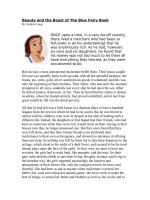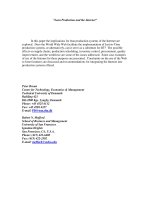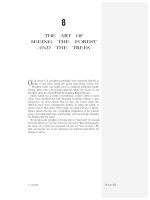Markov processes and the Kolmogorov equations
Bạn đang xem bản rút gọn của tài liệu. Xem và tải ngay bản đầy đủ của tài liệu tại đây (185.87 KB, 12 trang )
Chapter 16
Markov processes and the Kolmogorov
equations
16.1 Stochastic Differential Equations
Consider the stochastic differential equation:
dX t= at; X t dt + t; X t dB t:
(SDE)
Here
at; x
and
t; x
are given functions, usually assumed to be continuous in
t; x
and Lips-
chitz continuous in
x
,i.e., there is a constant
L
such that
jat; x , at; y j Ljx,yj; jt; x , t; y j Ljx,yj
for all
t; x; y
.
Let
t
0
;x
be given. A solution to (SDE) with the initial condition
t
0
;x
is a process
fX tg
tt
0
satisfying
X t
0
=x;
X t= Xt
0
+
t
Z
t
0
as; X s ds +
t
Z
t
0
s; X s dB s; t t
0
The solution process
fX tg
tt
0
will be adapted to the filtration
fF tg
t0
generated by the Brow-
nian motion. If you know the path of the Brownian motion up to time
t
, then you can evaluate
X t
.
Example 16.1 (Drifted Brownian motion) Let
a
be a constant and
=1
,so
dX t=adt+dB t:
If
t
0
;x
is given and we start with the initial condition
X t
0
=x;
177
178
then
X t=x+at,t
0
+Bt,Bt
0
; t t
0
:
To compute the differential w.r.t.
t
, treat
t
0
and
B t
0
as constants:
dX t=adt+dB t:
Example 16.2 (Geometric Brownian motion) Let
r
and
be constants. Consider
dX t=rX t dt + X t dB t:
Given the initial condition
X t
0
=x;
the solution is
X t=xexp
B t , B t
0
+ r ,
1
2
2
t , t
0
:
Again, to compute the differential w.r.t.
t
, treat
t
0
and
B t
0
as constants:
dX t=r,
1
2
2
Xtdt + Xt dB t+
1
2
2
Xt dt
= rX t dt + X t dB t:
16.2 Markov Property
Let
0 t
0
t
1
be given and let
hy
be a function. Denote by
IE
t
0
;x
hX t
1
the expectation of
hX t
1
, given that
X t
0
=x
.Nowlet
2 IR
be given, and start with initial
condition
X 0 = :
We have the Markov property
IE
0;
hX t
1
F t
0
= IE
t
0
;X t
0
hX t
1
:
In other words, if you observe the path of the driving Brownian motion from time 0 to time
t
0
,and
based on this information, you want to estimate
hX t
1
, the only relevant information is the value
of
X t
0
. You imagine starting the
SDE
at time
t
0
at value
X t
0
, and compute the expected
value of
hX t
1
.
CHAPTER 16. Markov processes and the Kolmogorov equations
179
16.3 Transition density
Denote by
pt
0
;t
1
; x; y
the density (in the
y
variable) of
X t
1
, conditioned on
X t
0
=x
.Inotherwords,
IE
t
0
;x
hX t
1
=
Z
IR
hy pt
0
;t
1
; x; y dy :
The Markov property says that for
0 t
0
t
1
and for every
,
IE
0;
hX t
1
F t
0
=
Z
IR
hy pt
0
;t
1
; Xt
0
;y dy :
Example 16.3 (Drifted Brownian motion) Consider the SDE
dX t=adt+dB t:
Conditioned on
X t
0
=x
, the random variable
X t
1
is normal with mean
x + at
1
, t
0
and variance
t
1
, t
0
, i.e.,
pt
0
;t
1
; x; y=
1
p
2t
1
,t
0
exp
,
y , x + at
1
, t
0
2
2t
1
, t
0
:
Note that
p
depends on
t
0
and
t
1
only through their difference
t
1
, t
0
. This is always the case when
at; x
and
t; x
don’t depend on
t
.
Example 16.4 (Geometric Brownian motion) Recall that the solution to the SDE
dX t=rX t dt + X t dB t;
with initial condition
X t
0
=x
, is Geometric Brownian motion:
X t
1
=xexp
B t
1
, B t
0
+ r ,
1
2
2
t
1
, t
0
:
The random variable
B t
1
, B t
0
has density
IP fB t
1
, B t
0
2 dbg =
1
p
2t
1
, t
0
exp
,
b
2
2t
1
, t
0
db;
and we are making the change of variable
y = x exp
b +r,
1
2
2
t
1
, t
0
or equivalently,
b =
1
h
log
y
x
, r ,
1
2
2
t
1
, t
0
i
:
The derivative is
dy
db
= y;
or equivalently,
db =
dy
y
:
180
Therefore,
pt
0
;t
1
;x; y dy = IP fX t
1
2 dyg
=
1
y
p
2t
1
, t
0
exp
,
1
2t
1
, t
0
2
h
log
y
x
, r ,
1
2
2
t
1
, t
0
i
2
dy:
Using the transition density and a fair amount of calculus, one can compute the expected payoff from a
European call:
IE
t;x
X T , K
+
=
Z
1
0
y , K
+
pt; T ; x; y dy
= e
rT ,t
xN
1
p
T , t
h
log
x
K
+ rT , t+
1
2
2
T ,t
i
,KN
1
p
T , t
h
log
x
K
+ rT , t ,
1
2
2
T , t
i
where
N =
1
p
2
Z
,1
e
,
1
2
x
2
dx =
1
p
2
Z
1
,
e
,
1
2
x
2
dx:
Therefore,
IE
0;
e
,rT ,t
X T , K
+
F t
= e
,rT ,t
IE
t;X t
X T , K
+
= X tN
1
p
T , t
log
X t
K
+ rT , t+
1
2
2
T ,t
, e
,rT ,t
KN
1
p
T,t
log
X t
K
+ rT , t ,
1
2
2
T , t
16.4 The Kolmogorov Backward Equation
Consider
dX t= at; X t dt + t; X t dB t;
and let
pt
0
;t
1
;x; y
be the transition density. Then the Kolmogorov Backward Equation is:
,
@
@t
0
pt
0
;t
1
; x; y =at
0
;x
@
@x
pt
0
;t
1
; x; y +
1
2
2
t
0
;x
@
2
@x
2
pt
0
;t
1
; x; y :
(KBE)
The variables
t
0
and
x
in
KBE
are called the backward variables.
In the case that
a
and
are functions of
x
alone,
pt
0
;t
1
; x; y
depends on
t
0
and
t
1
only through
their difference
= t
1
, t
0
. We then write
p ; x; y
rather than
pt
0
;t
1
; x; y
,and
KBE
becomes
@
@
p ; x; y =ax
@
@x
p ; x; y +
1
2
2
x
@
2
@x
2
p ; x; y :
(KBE’)
CHAPTER 16. Markov processes and the Kolmogorov equations
181
Example 16.5 (Drifted Brownian motion)
dX t=adt+dBt
p ; x; y=
1
p
2
exp
,
y , x + a
2
2
:
@
@
p = p
=
@
@
1
p
2
exp
,
y , x , a
2
2
,
@
@
y , x , a
2
2
1
p
2
exp
,
y , x , a
2
2
=
,
1
2
+
ay , x , a
+
y , x , a
2
2
p:
@
@x
p = p
x
=
y , x , a
p:
@
2
@x
2
p = p
xx
=
@
@x
y , x , a
p +
y , x , a
p
x
= ,
1
p +
y , x , a
2
2
p:
Therefore,
ap
x
+
1
2
p
xx
=
ay , x , a
,
1
2
+
y , x , a
2
2
2
p
= p
:
This is the Kolmogorov backward equation.
Example 16.6 (Geometric Brownian motion)
dX t=rX t dt + X t dB t:
p ; x; y=
1
y
p
2
exp
,
1
2
2
h
log
y
x
, r ,
1
2
2
i
2
:
It is true but very tedious to verify that
p
satisfies the KBE
p
= rxp
x
+
1
2
2
x
2
p
xx
:
16.5 Connection between stochastic calculus and KBE
Consider
dX t=aXt dt + X t dB t:
(5.1)
Let
hy
be a function, and define
v t; x= IE
t;x
hX T ;









